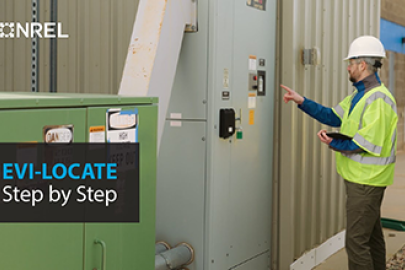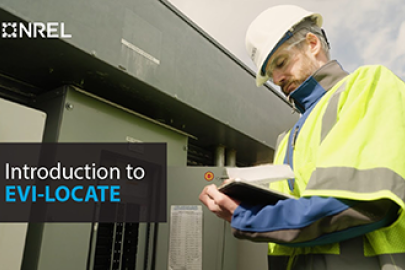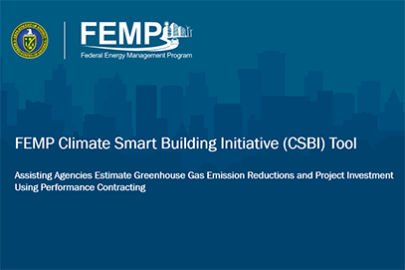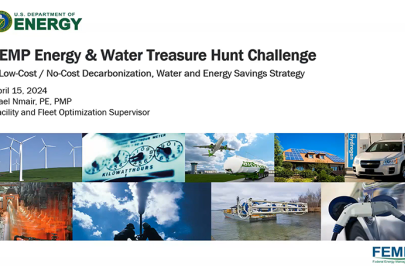This Take Five training provides a concise explanation of Energy Efficiency 101 concepts for federal procurement team members.
Federal Energy Management Program
April 22, 2024Got five minutes? The Take Five training series has you covered with very short trainings in buying clean, efficient goods and services for the federal government while doing your part to reduce carbon emissions.
The most cost-effective way of reducing energy costs and carbon emissions for a building is making sure that the equipment inside—cooling, heating, computers, lighting and so on—is efficient. The question that we often hear from federal buyers is, well, what does that mean? What is energy efficiency? This training is a very concise explanation, a kind of Energy Efficiency 101 for federal procurement team members. It breaks down the concepts, explains key metrics in easy-to-understand terms, and describes how to apply them to acquisitions.
This video is part of the Take Five series of short trainings on buying clean, efficient goods and services for the federal government. Learn more at Energy-Efficient Product Procurement Training for Federal Agencies.
Hello and welcome to Take Five, a series of quick lessons in sustainable purchasing. I'm Meena Venkatraman of Berkeley Lab, and today I'll cover some basics about energy efficiency. Federal agencies can unlock cost and carbon savings through energy efficiency - but what does it mean exactly? Let's break down this concept and apply it to buying products and services. Also we'll cover a lot of terms today, but no need to write them down - just see the handout accompanying this training.
So first, why does energy efficiency matter?
Buying efficient products is the law for federal agencies. It also saves money and carbon emissions. Energy use is really all around us. Your typical office building has windows and insulation that affect the building's energy use, and lots of energy-consuming equipment - heating and cooling systems, lighting, computers and more. Making it all more efficient really adds up across the tens of thousands of federal buildings.
So what does "energy efficiency" mean? Energy efficiency is the energy service - for example heating, lighting, or cooking - compared to the energy used to produce that service. Most of the time, it's basically output over input. With a more efficient version of the same product, you get the same energy service delivered, or output, using less energy, or input. This applies to every energy-consuming product, even your coffee maker. Energy efficiency is as simple as the electricity it takes to heat up your morning cup.
Efficiency means we need less fuel - whether that's natural gas or a cleaner fuel like electricity. As we move towards all-electric buildings, energy efficiency is an important first step to reduce the burden on the electric grid.
But how do you know whether a product is energy efficient? There are a lot of different ways energy efficiency is measured for different products. In most cases, efficiency goes back to output over input.
Take lighting, for example. The lighting efficiency metric is luminous efficacy - that's the light output in lumens over the power input measured in watts. A more efficient light would provide the same light output for less power, which means less cost and less carbon.
Let's take a look at another example. For large gas-fired boilers, combustion efficiency is the heat output over the gas input, both measured in BTUs. Buying a more efficient boiler keeps us just as warm while saving energy, costs, and carbon emissions.
Just like combustion efficiency for boilers, here are other metrics for heating and cooling efficiency, such as seasonal energy efficiency rating, or SEER, and Integrated Part Load Value, or IPLV. These are technical terms, but all you need to know is that most of the time, a higher value means a more efficient product.
We also have metrics for the energy it takes to heat water, bake a cake, and wash clothes. Again for most metrics, the higher the value, the more efficient your product is.
With so many metrics, which do you use and how high or low should it be? When buying energy using products, federal agencies are required to purchase things that are either certified by the Environmental Protection Agency's ENERGY STAR program or meet an efficiency level designated by the Department of Energy's Federal Energy Management Program, or FEMP. These requirements are written into statute and have an associated FAR clause.
Now to find the required efficiency, you can use GSA's Sustainable Facilities Tool at sftool.gov, your one-stop shop for sustainable procurement. You don't need to memorize the efficiency metrics - just use SFTool. Let's search for commercial boilers. From the Procurement Info section, click the link to the FEMP product page. Here you'll find buying tips and sample contract language to help you comply. Scroll down to find the required efficiency for different types of boilers.
Now you can ask your preferred vendor for a product that meets or exceeds the required efficiency. For solicitations, identify a compliant model and/or the required efficiency, in the technical specifications, or if you haven't chosen a specific product yet, just cite the FEMP or ENERGY STAR requirements. It's also good practice to include energy efficiency in the evaluation criteria and require vendors to document compliance.
That could be the manufacturer's tear sheet or another source like the nameplate. It could be as simple as showing the ENERGY STAR logo on the product. You can use these same steps for your service solicitations since the efficiency requirements apply to services as well.
That's the energy efficiency basics. Just remember efficiency is usually output over input, and a more efficient product saves you energy, money and carbon emissions. See the handout below for quick links to find the required efficiency.
To learn more, check out some of our other training, such as our previous Take Five videos on buying air-source heat pumps and buying energy efficient lighting. For more in-depth information, see our full length Contracting for Efficiency training. Thanks for tuning in to this edition of Take Five, and thank you for doing your part to meet federal law, save taxpayer dollars, and address climate change.










